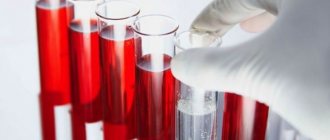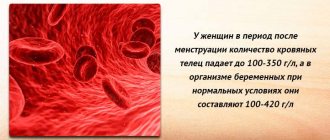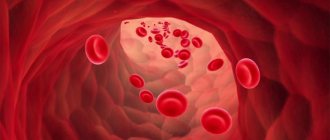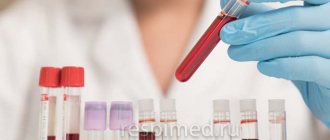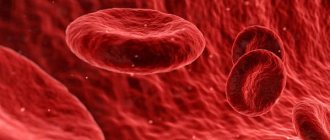Why are platelets needed?
Platelets ensure normal blood clotting. This function is based on the ability to adhesion, that is, to glue cells together. Normally, platelets do not form agglomerations with other blood cells, and also do not attach to the walls of blood vessels. When a capillary is damaged, a thrombus forms - a blood clot. It blocks damaged vessels, which helps stop bleeding. Functions of platelets:
- Nutritious
. This is the saturation of blood vessels with essential nutrients. Achieved due to the normal permeability of the capillary walls. - Construction
. These cells form connective material in the walls of blood vessels. Protective. Platelets help form the immune response. They can attach to foreign proteins that enter the body. This ability does not allow the infectious process to develop. - Exchange
. When platelets are destroyed, a number of substances are released that are involved in metabolic processes. These connections ensure the integrity of many tissues and vessel walls.
A normal platelet level ensures the maintenance of all vital processes. To identify indicators, you need to contact a medical laboratory. The definition is carried out in different ways. This may be a manual count using microscopy.
Colpitis is one of the most common female diseases. The pathology is based on inflammation of the vaginal walls, which occurs against the background of injuries, hormonal disorders and other unfavorable factors. Read more in the article: “atrophic colpitis: symptoms and treatment in women.”
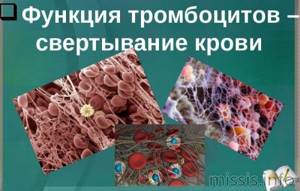
The most reliable results can be obtained by examining a material sample using a modern analyzer. Many medical centers are equipped with such devices. For diagnosis it is necessary to take a general blood test. The sample is taken from a finger or a vein. It is important to take it in the morning before breakfast.
Increase P-LCR
An increased number of large platelets means that there is a pathology in the body. Only in isolated cases is a high P-LCR value an individual characteristic of a person and does not require treatment.
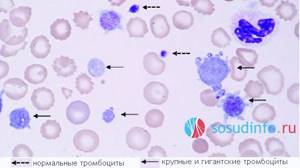
Etiology
The reasons for an increase in P-LCR can be completely different diseases - inflammatory, oncological, hematological, infectious.
But most often, the formation of a large number of large platelets occurs in autoimmune disorders. Systemic diseases that can cause thrombocytosis include: collagenosis (scleroderma, systemic lupus erythematosus, rheumatic diseases, periarteritis nodosa), sarcoidosis, polyarthritis, ankylosing spondylitis, enteropathy. These processes are accompanied by the release of interleukin and other inflammatory mediators into the blood, which stimulate the biosynthesis of thrombopoietin and the formation of a large number of platelets.
Along with this, the P-LCR index increases if the patient has:
- infectious pathology - bacterial, viral, fungal, parasitic,
- post-traumatic and postoperative syndrome,
- oncological and hematological diseases - lymphoma, neuroblastoma and hepatoblastoma, anemia,
- spleen diseases,
- cirrhosis or polycystic liver disease,
- damage or inflammation of the spinal cord,
- alcoholism,
- intoxication with chemicals that disrupt bone marrow function,
- atherosclerosis,
- diabetes mellitus
Some scientists believe that the increase in P-LCR is due to a congenital stem cell defect. In patients, the process of platelet formation is disrupted. The large cellular elements produced are defective and inactive. They are unable to adequately interact with other structures and function fully.
A high P-LCR index leads to the fact that the patient has a tendency to thrombosis. Due to the adhesive properties of platelets, they stick together and form a blood clot, which disrupts blood circulation and prevents the free movement of blood. As the thrombus grows, it narrows the lumen of the vessel, disrupts the blood supply to the organ, and causes hypoxia and ischemia of the tissue. When the coronary arteries are damaged, this leads to myocardial infarction. With thrombosis of cerebral vessels, an ischemic stroke develops. The result of the process is often varicose veins or atherosclerotic changes in the arteries. These pathologies are deadly and often result in the death of patients.
Symptoms
When the P-LCR increases, the patient develops corresponding clinical signs. They may go unnoticed behind the obvious symptoms of the causative disease. Such patients are not treated for thrombocytosis, which further aggravates the situation.

An increase in P-LCR is manifested by the following symptoms:
- hypersensitivity and pain in the fingertips,
- causeless appearance of hematomas,
- irritation and itching of the skin,
- cyanosis,
- asthenia of the body,
- rapid heartbeat,
- shortness of breath at rest,
- visual dysfunction.
These signs are optional. They can appear individually or in various combinations. But despite this, the patient needs to visit a health care facility and undergo certain tests, based on the results of which doctors will determine the cause of the P-LCR deviation and prescribe appropriate treatment.
Treatment and diagnostic procedures
To determine the cause of the disorder and make a correct diagnosis, in serious cases, a bone marrow biopsy is examined and blood is taken again. Additionally, general clinical and molecular tests and ultrasound of internal organs are performed.
To normalize the P-LCR value, the causative disease . If the pathology is not treated, the patient risks dying from thrombosis, or more precisely from its consequences - acute coronary or cerebral failure. These phenomena are very dangerous. They are often fatal. That is why this deviation needs to be corrected. Hematologists carry out diagnostic and treatment measures. Restoration of normal P-LCR levels in a blood test is a sign of adequate and effective therapy.
- Patients are prescribed a diet rich in vegetables and fruits, vegetable oils, freshly squeezed juices and other products that make the blood less viscous. For the same purpose, experts recommend optimizing your drinking regime - drinking up to 2-3 liters of water per day.
- To prevent thrombosis and its consequences, the use of antiplatelet agents and anticoagulants is indicated - Aspirin, Cardiomagnyl, Trental, Cavinton, as well as drugs that improve microcirculation - Dipyridamole, Piracetam, Vinpocetine.
- If the cause of a high level of large platelets is an infectious disease, then after intensive antibiotic therapy, the P-LCR index value returns to normal almost immediately.
- In severe cases, the use of corticosteroids - Prednisolone, Dexamethasone and cytostatics - Anagrelide, Hydroxyurea, Radioactive phosphorus 32P is indicated.
- To stimulate the immune system, Interferon and its derivatives are prescribed.
- There are folk remedies that allow you to correct (but not eliminate) existing violations. These include: mulberry poison, sweet clover infusion, ginger tea, celery juice. These plants have a beneficial effect on the condition and activity of platelets.
Causes of the primary form
The reasons for the increase in platelets in the blood of women are varied. They can be both primary and secondary in nature. Primary thrombocytosis
- a disease caused by a dysfunction of stem cells in the bone marrow.
The most common cause of this disease is problems with the autoimmune system
.
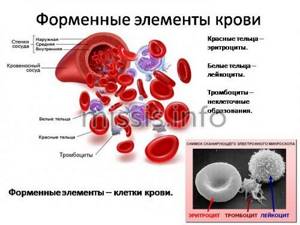
Table of platelet norms in women by age:
| Age | Quantity (thousand/µl) |
| 15-18 years old | From 180 to 340 |
| 18-80 years | From 180 to 320 |
The body begins to perceive its own tissues as pathogenic, which is why such pathogenic responses are formed. The causes of primary thrombocytosis include:
- acute infections
: tuberculosis, tonsillitis, pneumonia, rubella; - blood diseases
: anemia, erythrocytosis, myeloid leukemia, hemolysis, leukemia; - acute poisoning
and large blood loss; - hereditary diseases
: thrombocytopenia, histiocytosis, Chedik-Higashi anomaly, Fanconi syndrome, Bernard-Soulier syndrome and others; - bone marrow lesions
: formation of metastases, bone tuberculosis, radiation after chemotherapy;
- viral infections
: rickettsiosis, malaria, HIV infection; - frequent bleeding
: both internal and external; - diseases
in which platelet consumption increases: disseminated intravascular coagulation syndrome, thrombocytopenic purpura, hemodialysis.
Only a specialist can tell you why your platelet levels are high.
Primary thrombocytosis
- myeloproliferative syndrome, which is characterized by the independent proliferation of hematopoietic sprouts in any organ.
Because of this, an excessive number of platelets enter the peripheral blood. In most cases, this disease affects older women; it is rarely diagnosed in young women. Treatment is determined only after a bone marrow myelogram. [media=
https://youtu.be/6f7FjnUYSCc
]
Functions and norms of platelets
Platelets are anucleate, colorless, flat blood cells. Formed in the bone marrow. Some enters the bloodstream, the other accumulates in the spleen. Life expectancy is no more than 10 days; they disintegrate in the spleen and liver.
The average platelet count in an adult in a general blood test is 150-400 thousand units/μl.
Women have lower rates than men. The values vary depending on the phase of the menstrual cycle and trimester of pregnancy. A person's age does not affect platelet cell levels.
The main function of platelets is to stop bleeding when the integrity of the skin and internal organs is violated. Cells participate in the metabolism of serotonin, capture and destroy pathogens. Blood plates accumulate biologically active substances that enter the bloodstream when a platelet dies. This promotes the growth of new cells.

Causes of the secondary form
Secondary thrombocytosis
- increased platelet levels caused by high levels of these substances in the blood.
Most often, such changes in the body are characterized by a chronic course. Among the most common causes of thrombocytosis in women are injuries, internal inflammation, and hematological abnormalities in functioning. In addition, secondary thrombocytosis can be caused by:
- Infections
- most often the disease occurs due to the influence of any bacteria or virus on the body. The influence of such substances can be recognized by changes in certain indicators: white blood cells and leukocytes increase. This indicates the presence of an inflammatory process. - Hematological disorders
- Low iron levels can cause a high platelet count in the blood. Such changes are characteristic of acute blood loss, anemia, and the consequences of chemotherapy.
- Removal of the spleen
- 30% of all platelets are constantly located in this organ. During the removal of this organ, the blood cells contained in it enter the general channel, which is why the platelet count begins to grow rapidly. - Injury or surgery
- in this case, the body is affected by post-traumatic stress and the consequences of the operation. Also, the number of platelets in women increases due to pancreatitis, enterocolitis, and tissue necrosis. - Inflammatory processes
- due to increased levels of interleukin - an anti-inflammatory protein - the level of the hormone thrombopoepin increases. This substance promotes accelerated maturation, division and release of platelets. - Malignant tumors
- lymphomas, hepatoblastomas, neuroblastomas. - Taking certain medications
.
[media=
https://youtu.be/arLn-Z53ib0
]
How to avoid high platelet levels?
If you are predisposed to thrombocytosis, simple rules of prevention must be followed to prevent the development of complications. These simple measures will not only help keep platelet cell counts normal. But they will also have a beneficial effect on the condition of the body as a whole.
Preventive measures:
- drink enough water per day, avoid dehydration in case of poisoning or fever;
- to refuse from bad habits;
- monitor your weight, eat a healthy, balanced diet, reduce the amount of salt and fat in your diet;
- women replace birth control pills with another method of birth control;

- play sports, walk in the fresh air.
One of the main provocateurs of thrombocytosis is stress. During experiences and fear, adrenaline is released into the blood. Which leads to an increase in platelet count. The ability to relax and adherence to a daily routine is the best prevention of the development of complications of stressful situations.
Symptoms of the primary form
In most cases, thrombocytosis manifests itself only in the case of the primary form. Adult women often do not pay attention to the emerging signs of this disease, which subsequently leads to disastrous consequences. Most often, this disease is diagnosed completely by accident when a woman receives the results of a blood test. Primary thrombocytosis can be recognized by the following symptoms:
- headache is the very first sign of the primary form;
- frequent nosebleeds;

- decreased body strength;
- pain in the fingertips - occurs due to a rush of blood to the extremities;
- constant itching of the skin;
- weakness, lethargy;
- decreased visual acuity.
If you notice at least a few of these changes, consult your doctor immediately.
To suspect thrombocytosis, a woman does not have to notice all the symptoms at once. To do this, it is enough to diagnose yourself with at least 2-3 certain signs
.
The vaginal secretion of a completely healthy girl is characterized by a characteristic, barely perceptible odor that does not cause disgust. The appearance of a nauseating fishy odor indicates a violation of the vaginal microflora and a deterioration of the bacterial or fungal composition. Read more in the article: “discharge with a fishy odor in women: causes, treatment.”
The manifestations of this disease should not be ignored, as there is a high risk of serious complications. Pregnant women need to be more attentive to the condition of their body. Primary thrombocytosis is especially dangerous with a high risk of plaque formation in the veins.
High platelet count - how to recognize
If thrombocytosis is caused by any disease, then recognizing the symptoms is difficult. Manifestations of primary pathology come to the fore. If there is no history of serious illness, an increase in the level of platelet cells can be suspected based on characteristic signs. Often, simultaneously with platelets, the number of lymphocytes and neutrophils increases.
Pomegranate is a natural source of vitamins, micro- and macroelements and other biologically active substances. Due to its rich composition and medicinal properties, the juicy fruit and its juice are widely used to improve hematopoiesis and the functioning of the digestive system, increase immunity and prevent many diseases. Read more in the article: “Pomegranate juice - beneficial properties and contraindications.”
Symptoms of thrombocytosis:
- nasal, uterine, intestinal bleeding, bleeding gums;
- severe pain in the fingertips;
- constant itching;
- causeless appearance of bruises and bruises;
- swelling, bluishness of the skin;

- increased fatigue, weakness;
- cramps, constantly cold lower extremities, pain in the legs when walking;
- poor wound healing;
- arrhythmia, shortness of breath, dizziness;
- visual impairment.
To determine the level of platelets, it is necessary to do a general blood test with an expanded leukocyte formula and determine the erythrocyte sedimentation rate. Additional examinations - ferritin test, extended coagulogram, biochemical blood test. Ultrasound, bone marrow tissue biopsy. To identify the causes of primary thrombocytosis, genetic studies are performed.

Medicines to reduce platelets
The choice of drugs for the treatment of thrombocytosis depends on the diagnostic results. When drug therapy for the primary form of the disease, it is necessary to take into account the person’s age and the presence of chronic diseases. In the secondary form, the root cause that provoked the growth of platelet cells is eliminated.
List of medicines:
| Group | Action | Titles |
| Anticoagulants | Reduce blood clotting. | Aspirin, Warfarin. |
| Antiplatelet agents | Prevents platelets from sticking together, which prevents the formation of blood clots. | Curantil, Ticlopidine. |
| Immunostimulants | Strengthen the body's protective functions. | Interferon-based drugs. |
| Specific drugs | Reduce platelet levels. | Anagrelide. |
| Antitumor agents | Affects bone marrow function. | Hydroxyurea. |
| Vasodilators | Improve blood circulation, normalize redox processes. | Xanthinol nicotinate. |
| Medicines with ginkgo biloba | Reduce blood viscosity and prevent the formation of clots. | Tanakan, Bilobil Forte. |

It is useful to take vitamin complexes. But before you start taking it, it is better to do an analysis of the level of vitamins A, C, B12. Lack and excess of these substances negatively affects the process of hematopoiesis.
During treatment, it is advisable to stop taking antibiotics, antidepressants, diuretics, and contraceptives.
If there is no effect from drug treatment, thrombocytopheresis is prescribed. The procedure helps to quickly reduce the level of platelet cells. It is carried out using a special apparatus - human blood is separated and platelets are isolated. A catheter is placed on the arm. The blood flows through the tube into the device and is purified. Returns to the body through a catheter on the second arm.
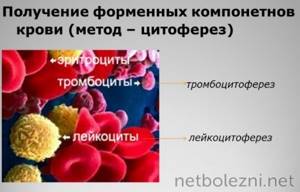
Folk remedies
One of the most effective methods of treatment and prevention of thrombocytosis is hirudotherapy. When using leeches, blood viscosity decreases, the condition of blood vessels and microcirculation improves. Leech therapy has antimicrobial, antihypoxic, analgesic, and immunostimulating effects.
At home, herbs can be used to thin the blood and reduce the number of platelet cells. They can be used if the indicators slightly deviate from the norm. In severe cases - only in combination with medications. To reduce the number of platelets, you need to drink 15 ml of sesame oil after each meal.
Nettle quickly thins the blood. Pour 200 ml 1 tbsp. l. crushed dry raw materials. Simmer over low heat for 10 minutes. Leave in a sealed container until cool. Drink 70 ml strained before meals. Course duration is 3-4 weeks.

Sweet clover reduces platelet cell counts. Pour 250 ml of boiling water 1 tsp. herbs. Leave in a sealed container for half an hour. Divide the infusion into 3-4 servings and drink throughout the day. The duration of treatment is 1 month.
An effective remedy for reducing blood viscosity is garlic. Peel 2 medium heads, crush a little, pour in 20 ml of vodka. Place in a cool, dark place for 30 days, strain. Drink 0.5 tsp. in the morning and in the evening. Continue treatment until the tincture ends.
Place 50 g of ginkgo biloba leaves in a glass container and pour in 500 ml of vodka. Leave for 14 days, strain. Drink 1 tsp before meals. for a month.

Foods that lower platelet levels
To lower the level of platelets in the blood, you need to change your diet. Add foods with a thinning effect to the menu. Avoid foods that thicken the blood.
What foods reduce platelet levels in the blood:
- Ginseng. Prevents the formation of blood clots. But it negatively affects the quality of sleep and can cause insomnia.
- Dry red wine. When consumed in moderation, platelet levels decrease, blood circulation improves, and hemoglobin levels increase.
- Cucumbers, sea buckthorn, currants, raspberries, raisins. Contains salicylate - a substance that reduces blood viscosity.
- Cinnamon. Activates blood circulation, prevents the formation of blood clots by preventing platelets from sticking together.
- Natural black coffee. Drink with antithrombotic effect. The daily dose is no more than 2-3 cups per day. It's better to drink decaffeinated coffee.
- Fish oil, flaxseed oil, olive oil, ginger, celery.

- Tomatoes, tomato juice, green apples, herbs, beets.
- Garlic. In its raw form, it thins the blood, cleanses blood vessels, and improves the functioning of the immune system. Excessive consumption of raw garlic destroys the gastric mucosa.
- Dark chocolate. 1-2 slices after meals.
To maintain the functioning of the cardiovascular system, you need to eat fish and seafood 2-3 times a week. Unsaturated fatty acids prevent blood clots. The most useful species are wild salmon, cod, pollock, tuna, and pike perch. Shellfish contain iodine, which is necessary for the normal functioning of the thyroid gland.
Prohibited Products
Foods that contain a lot of iron, calcium, and some other substances increase the number of platelets. At elevated values, they should be consumed in minimal quantities. Or completely exclude it from the diet. What foods increase platelet levels:
- any types of liver;
- spicy, fatty, fried foods;

- sauces, ketchups;
- nuts;
- pomegranate, rosehip decoction;
- buckwheat porridge, lentils;
- milk, dairy products;
- black currant, gooseberry, mulberry;
- mango, pitahaya, papaya, rambutan, bananas.
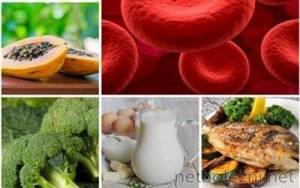
In addition to the correct diet, it is necessary to change your lifestyle. Give up bad habits, don’t overeat, exercise in moderation, avoid stressful situations. It is advisable to get out more often into the mountains, forest, sea, and other places with a favorable environmental situation.
It is imperative to maintain a drinking regime. The daily norm is 1.5-2 liters per day, depending on the individual characteristics of the body. With a lack of water, the blood becomes thicker, circulation is impaired, and tissues suffer from a lack of oxygen. All this leads to an increase in platelet levels.
Symptoms of the secondary form
Secondary form of thrombocytosis
- a latent course of the disease that does not manifest itself with external signs.
The disease can only be recognized based on the results of functional diagnostics. Doctors make this diagnosis when:
- hemorrhagic syndrome;
- neurological disorders: cerebral ischemia, microcirculation pathologies;
- disruption of pregnancy or miscarriage;

- thrombosis or thromboembolism;
- erythromelalgia - low vasomotor reflexes.
It is quite difficult to recognize the secondary form of thrombocytosis in women.
. External signs may be absent at all or may differ depending on the characteristics of the organism. The disease can be suspected by a constant feeling of fullness in the abdomen, pain in the joints, subcutaneous bleeding, chronic fatigue, shortness of breath, and migraines. It is advisable to consult a doctor if you have at least several signs. If necessary, he will give you medication to reduce the number of these cells.
Consequences of low platelet count
In a state of low platelet count, disorders subsequently develop, which include frequent bleeding (menstrual and nosebleeds), while the bleeding time increases significantly and becomes difficult to stop. Sudden gum bleeding may develop (not everyone does). Blood clots may be found in urine or stool. Petechiae (red dots resulting from damage to the capillary wall) appear on the skin of the lower extremities, most often the legs. Even minimal damage leads to the formation of ecchymoses (bruises), when normally a bruise would not appear.
The severity of symptoms directly depends on the platelet count. The fewer platelets, the more severe the clinic. If the platelet count is very low, internal bleeding into the digestive tract or even bleeding into the brain may occur.
Even in the presence of a mild clinic, it is recommended to consult a general practitioner in order to prevent this condition.
How to treat pathology
Scientists do not know why the bone marrow begins to produce more megakaryocytes, which increase the production of blood platelets, and what to do to normalize their number. This means that therapy comes down not to eliminating the cause of the pathology, but to treating the consequences. Excess blood cells are treated with medication. Appointed:
- drugs that reduce blood clotting (anticoagulants);
- medications that prevent platelets from sticking together (antiplatelet agents);

- interferon, which stimulates the immune system;
- Anagrelide is a drug that inhibits the formation of platelets from megakaryocytes.
In some cases, when there is a tendency to further increase, doctors resort to the procedure of plateletpheresis. The blood is separated to reduce the excess level of blood cells. It must be remembered that blood viscosity increases:
- hormonal drugs;
- contraceptives;
- diuretics;

- smoking;
- alcohol.
Information about these factors should be reported to your doctor.
What do you need to remember?
Thrombocytosis is a consequence of disorders in the bone marrow, infections, bleeding, and malignant tumors. Minor deviations can be caused by pregnancy, stress, overwork, alcohol abuse or abrupt cessation of alcohol. The pathology often occurs without pronounced symptoms. Therefore, to monitor platelet counts, you need to take a general blood test 1-2 times a year.
Treatment is aimed at identifying and eliminating the causes that provoked an increase in the number of platelet cells. Once the underlying disease is eliminated, the values are restored to normal levels. Folk remedies, diet - auxiliary methods of therapy.
Tibetan healing methods
Diagnostics in Tibetan medicine, in addition to traditional methods, includes:
- Inspection
. The specialist examines the general appearance of the patient: body features, posture, how he walks, how he speaks. Carefully examines the condition of the eyes, tongue, skin, and lymph nodes. - Survey
. The doctor collects a detailed medical history: finds out what events preceded the onset of the disease, what lifestyle the patient leads, how he reacts to stressful situations, and what food preferences he has. - Pulse diagnostics
. Based on the nature of the pulse, a doctor of Tibetan medicine determines the condition of each individual organ and the body as a whole, and identifies the disease in its very infancy.

Depending on the diagnosis, the patient is prescribed individual treatment. In oriental medicine centers, it consists of a set of therapeutic measures and procedures that make it possible to eradicate the real cause of the disease, and not just eliminate visible clinical symptoms. Much attention is paid to correcting the patient’s lifestyle, including a transition to proper nutrition, the introduction of reasonable physical activity and achieving a balanced state of the nervous system.

A set of external procedures, including energy acupressure, acupuncture, stone therapy, moxotherapy, vacuum therapy, restores energy balance, normalizes regulatory and metabolic processes, activates organ functions, and improves blood circulation. Herbal medicine is an effective method of treating thrombocytosis. Tibetan herbal remedies and Baikal herbs cleanse the blood and tone the walls of blood vessels.
Foods that affect platelets
The following foods raise blood platelet levels when levels are low in adults:
- Liver
. It donates a large amount of iron, which is necessary for the normal function of the hematopoietic system.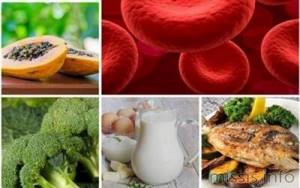
- Buckwheat
. Contains a high level of protein, which is required for synthetic processes occurring in the body. - Fruits (apples, bananas, oranges)
. Fruits contain a large amount of various vitamins required for all synthetic processes during hematopoiesis. - Fish (sea species)
. Contains a large amount of protein and elements required for the formation of blood cells. - Dairy
. These products contain a high content of calcium and protein, without which biochemical processes in the human body do not occur.

When dieting to reduce platelet counts, the following rules must be followed:
- Eat meals at the same time every day.
- Eliminate from your diet foods that contain large amounts of fats and carbohydrates.
- Include foods containing iodine and organic acids in your diet.

The following foods are prohibited on this diet:
{banner_banstat8}
- drinks containing alcohol;
- cereals;
- smoked meats;

- sweet carbonated drinks;
- various confectionery products.
Foods that should be included in the diet to achieve normal platelet values have been presented previously.
Elevated platelets in pregnant women

The cause of thrombocytosis in the first trimester is dehydration
During pregnancy, platelet levels usually decrease as a result of increased blood volume. Increased values can be observed in the first trimester if dehydration occurs due to toxicosis. It is recommended to consume more fluids, as well as foods rich in iron.
A physiological increase is characteristic of the final phase of the third trimester, when a woman’s body is preparing for childbirth. By increasing platelet synthesis, the circulatory system is protected from increased blood loss during labor.
In other cases, thrombocytosis is an indicator of pathology. The doctor monitors platelet levels over time, finds out the reason for the increase and prescribes therapy.
To reduce the risk of blood clots, the drug Curantil may be recommended.


